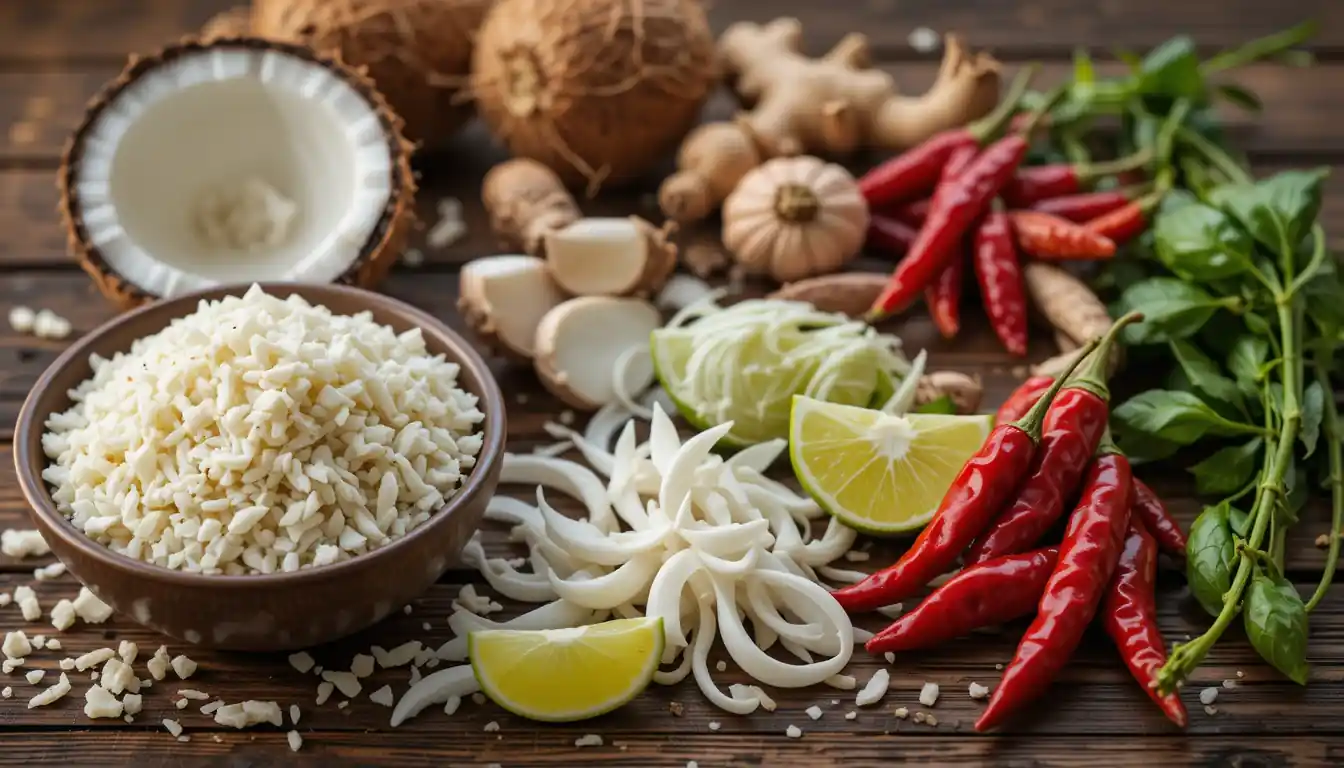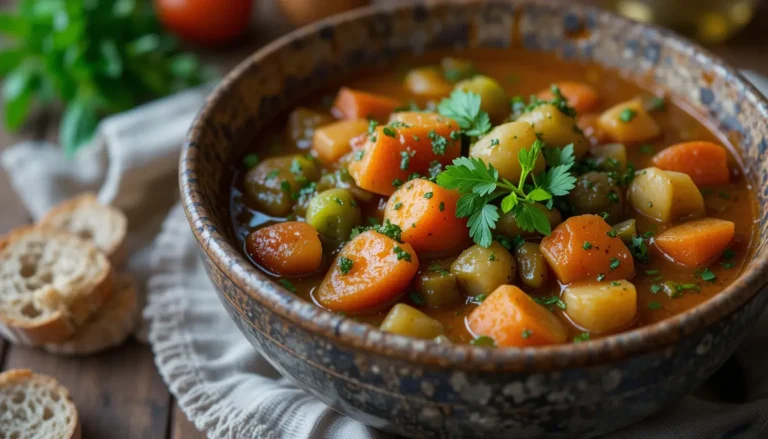Irresistible Sri Lankan Coconut Sambal: Ignite Taste!
Sri Lankan Coconut Sambal is a delicious, vibrant condiment that captures the essence of Sri Lankan cuisine. This unique sambal blends the creaminess of coconut with a burst of spices and fresh ingredients to create a versatile accompaniment ideal for many dishes. Whether you serve it with rice, bread, or even grilled meats, its tropical flavor profile elevates any meal. In this article, we will explore the origins of Sri Lankan Coconut Sambal, delve into its ingredients, and guide you through a step-by-step recipe that you can easily follow at home.
The Cultural Significance of Sri Lankan Coconut Sambal
Sri Lankan cuisine is renowned for its bold and intricate flavors, and sambals play a central role in this culinary tradition. Sri Lankan Coconut Sambal, with its harmonious balance of spicy, sweet, and savory notes, embodies the island’s love for combining fresh local ingredients with aromatic spices. This sambal is not only a condiment; it is a story of culture, tradition, and the abundance of tropical produce. The use of coconut, which is abundant in Sri Lanka, along with local herbs and spices, reflects the resourcefulness and creativity of Sri Lankan home cooking.
What Makes Sri Lankan Coconut Sambal So Special?
The magic of Sri Lankan Coconut Sambal lies in its simple yet flavorful composition. Unlike many other condiments, this sambal relies on a few primary ingredients to achieve its complex flavor profile. The fresh grated coconut provides a rich, nutty texture, while the blend of chilies, garlic, and shallots contributes to a spicy kick balanced by a tangy citrus note. This blend offers a delightful contrast that enhances the taste of simple steamed rice or transforms a plain grilled fish into an exotic feast.
Essential Ingredients for Sri Lankan Coconut Sambal

Preparing an authentic Sri Lankan Coconut Sambal requires just a handful of fresh ingredients that are easy to find in most local markets. The foundational elements include freshly grated coconut, red chilies, garlic, shallots, fresh ginger, lime juice, and curry leaves. Each ingredient brings its unique character to the sambal, creating a condiment that is at once refreshing and intense. Fresh coconut lends a creamy texture, while red chilies add the heat. Garlic and ginger infuse the sambal with an aromatic spice, and lime juice introduces a splash of acidity that brightens the overall flavor.
Step-by-Step Recipe for Sri Lankan Coconut Sambal
Below is a detailed, easy-to-follow recipe that will help you recreate the bold flavors of Sri Lankan Coconut Sambal at home.
Preparing the Ingredients
Begin by gathering all the necessary ingredients. It is important to use fresh produce to achieve the authentic taste of this sambal. Wash the red chilies and remove the seeds if you prefer a milder version, though keeping the seeds will intensify the heat. Peel and mince the garlic and ginger finely to ensure that their flavors meld seamlessly into the coconut.
Fresh grated coconut is the star of this recipe. If you have access to a mature coconut, you can grate it yourself; otherwise, look for unsweetened, desiccated coconut that can be rehydrated with a little water. Equally, fresh shallots and curry leaves are essential for that unmistakable Sri Lankan aroma.
Blending the Ingredients

Once your ingredients are ready, the next step is blending them into a smooth mixture. In a food processor, combine the grated coconut, red chilies, garlic, shallots, ginger, and a few fresh curry leaves. Drizzle in the lime juice gradually as you blend, which not only assists the mixing process but also helps to balance the flavors. The consistency should be chunky enough to give the sambal a bit of texture, yet smooth enough to serve as a condiment.
For those who prefer a slightly warmed spice profile, lightly toast the curry leaves in a dry pan before adding them to the processor. This extra step releases the natural oils in the leaves, making the sambal even more aromatic.
Adjusting the Flavors
After blending, taste the mixture and adjust the seasoning as per your preference. You may opt to add a pinch of salt or a little extra lime juice to brighten the flavors further. Some cooks also add a small dash of turmeric for color, although this is optional and not traditional. The goal is to achieve a balance where the creaminess of the coconut complements the heat of the chilies and the zest of the lime.
Final Touches and Serving
Transfer the blended mixture into a serving bowl, and let the flavors meld for at least 30 minutes before serving. This resting time is key because it allows the spices to integrate thoroughly with the coconut. The finished sambal can be served immediately after resting, or it can be refrigerated for a few hours to intensify the flavors further.
Sri Lankan Coconut Sambal can be used as a dip, a spread, or an accompaniment to main dishes. Its vibrant flavor pairs wonderfully with steamed rice, grilled seafood, or roasted vegetables. In Sri Lankan homes, it often accompanies traditional dishes, enhancing each bite with its tangy and refreshing taste.
Tips and Variations to Perfect Your Recipe
While the classic Sri Lankan Coconut Sambal is delightful on its own, there are many creative ways to tweak the recipe to suit your personal taste or experiment with new flavor profiles.
Adjusting the Heat Level
If you prefer a less spicy sambal, consider reducing the number of red chilies or removing some of their seeds before blending. Conversely, for those who enjoy intense heat, keeping the seeds or even adding a few extra chilies can elevate the spiciness without overpowering the other flavors.
Experimenting with Textures
The texture of your sambal can also be modified to fit your culinary desires. For a smoother consistency, blend the mixture for a longer period until it reaches a creamy texture. Alternatively, if you enjoy a bit of crunch, pulse the ingredients just enough to keep some bits of coconut intact.
Adding Other Ingredients
Some households add a few twists to the traditional recipe. For instance, a small handful of roasted peanuts can be blended in for an earthy flavor and crunchy texture. Others incorporate a touch of jaggery (a type of unrefined sugar) to balance out the heat if the sambal turns out too fiery for your taste. However, if you decide to experiment with additional ingredients, remember to adjust the seasoning gradually to maintain the authentic flavor profile of Sri Lankan Coconut Sambal.
Serving Suggestions for a Complete Meal
Sri Lankan Coconut Sambal is incredibly versatile. It can be served as a dip with crispy papadam, as a side with steamed rice and lentils, or even as a dressing over fresh salads. In many Sri Lankan households, this sambal is enjoyed with string hoppers or appam—a type of pancake—which helps to mellow out the bold flavors of the sambal with their soft, neutral taste. Consider pairing it with a refreshing cucumber salad or a tangy tomato chutney to enhance your meal even further.
The Health Benefits of Sri Lankan Coconut Sambal
Beyond its irresistible taste, Sri Lankan Coconut Sambal offers several health benefits that make it a worthwhile addition to your diet. Coconut is known for its healthy fats that can contribute to improved digestion and provide a quick source of energy. The inclusion of fresh garlic and ginger not only fortifies the immune system but also aids in reducing inflammation. Additionally, the antioxidants present in red chilies help boost metabolism, making this sambal not only flavorful but also nutritious.
Bringing Authentic Sri Lankan Flavors to Your Kitchen
Mastering the art of making Sri Lankan Coconut Sambal opens up a window into the diverse world of Sri Lankan cuisine. This sambal is a true testament to the power of simple, fresh ingredients and traditional cooking techniques. By embracing this recipe, you can add a piece of Sri Lankan heritage to your kitchen, delighting your family and friends with its exotic taste and vibrant aroma.
Preparing authentic regional recipes like this sambal can be a fun and rewarding experience. It provides an opportunity to explore new flavors while also learning about the rich culinary traditions that define regions like Sri Lanka. Serving Sri Lankan Coconut Sambal at your next family dinner or festive gathering is sure to impress your guests and spark conversations about culture, history, and food.
Final Thoughts
Sri Lankan Coconut Sambal is more than just a condiment; it is a celebration of Sri Lankan culinary artistry. Its irresistible blend of creamy coconut, fiery chilies, and aromatic spices makes it a versatile addition to many meals. As you experiment with this recipe in your own kitchen, you may discover your personal twist on this traditional sambal, creating memories of flavor and warmth that last a lifetime.
Whether you are a seasoned cook looking to expand your repertoire of international dishes or a curious food enthusiast eager to explore something new, Sri Lankan Coconut Sambal offers a delightful journey into one of the most colorful and flavorful cuisines of the world. Embrace the process, adjust the ingredients to suit your taste, and most importantly, enjoy the vibrant taste of Sri Lankan Coconut Sambal in every bite.
Making this sambal can transform your cooking and add a unique, tropical complexity to your meals. Gather your fresh ingredients, follow the step-by-step process outlined in this article, and treat yourself to the exotic flavors of Sri Lanka right in your home. Enjoy the process, savor the flavors, and let Sri Lankan Coconut Sambal become a cherished favorite on your dining table.
Recipe Card
Irresistible Sri Lankan Coconut Sambal: Ignite Taste!
Course: CondimentCuisine: Sri Lankan4
servings15
minutes5
minutes300
kcal50
minutesExperience the vibrant flavors of Sri Lanka with this authentic Coconut Sambal. Combining freshly grated coconut with red chilies, garlic, ginger, and lime juice, this spicy, tropical condiment is a perfect accompaniment to steamed rice, grilled seafood, or roasted vegetables. Its balanced heat and refreshing tang make it an enduring favorite in Sri Lankan cuisine.
Ingredients
2 cups freshly grated coconut
• 4-5 red chilies (use whole or deseeded for less heat)
• 4 cloves garlic, peeled and minced
• 2 shallots, finely chopped
• 1-inch piece fresh ginger, minced
• Juice of 1 lime
• A handful of fresh curry leaves (lightly toasted for enhanced aroma)
• Salt, to taste
Directions
- Prepare Ingredients: Begin by washing the red chilies. If you prefer a milder sambal, remove the seeds before use. Peel and finely mince the garlic and ginger. Chop the shallots into small pieces. If you’re using a fresh coconut, grate it to yield 2 cups of coconut; alternatively, prepare unsweetened, rehydrated desiccated coconut. Gather the fresh curry leaves, optionally toasting them lightly in a dry pan to intensify their aroma.
- Blend the Mixture: In a food processor, combine the grated coconut, red chilies, minced garlic, chopped shallots, ginger, and curry leaves. Gradually drizzle in the lime juice while processing to help integrate the ingredients. Aim for a chunky yet cohesive texture, ensuring that the sambal retains some texture while melding into a flavorful paste.
- Season and Adjust: Taste the blend and add salt accordingly. If needed, adjust the lime juice to boost the tang or include a pinch of turmeric for color, though this is optional. The objective is to strike a harmonious balance between the creamy coconut, the heat from the chilies, and the zestiness of the lime.
- Rest and Serve: Once blended, transfer the sambal into a serving bowl. Allow the mixture to rest for at least 30 minutes at room temperature. This resting period is crucial, as it lets the spices and flavors fully develop and integrate. Serve the Sri Lankan Coconut Sambal as a dip, spread, or side condiment, pairing it with your favorite main dish for an enhanced exotic flavor experience.
Notes
- Optional Serving Suggestion:
For a complete meal experience, serve the sambal alongside steamed basmati rice or traditional Sri Lankan string hoppers. You may also enjoy it as a vibrant dip with crispy papadums or a refreshing cucumber salad.
Nutritional Note:
This sambal not only adds a burst of flavor to your dishes but also provides healthful benefits from the coconut’s healthy fats, the antioxidant properties of red chilies, and the anti-inflammatory benefits of garlic and ginger.








